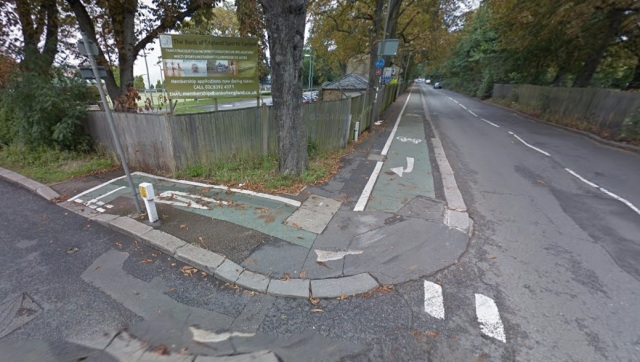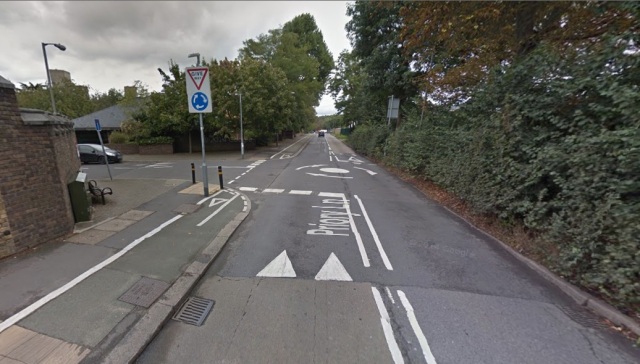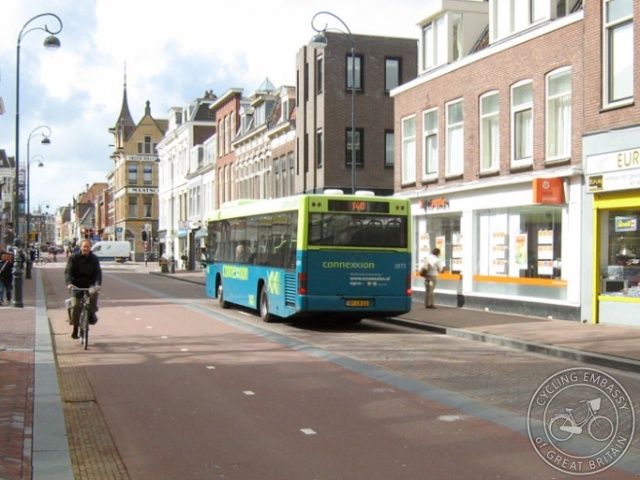The media storm after that incident now appears to be moving into its final stages as the driver involved has apologised.
Without wishing to comment on the individual behaviour on display, it’s fairly obvious that the layout on the road in question is almost a recipe for conflict. A through-route for motor traffic is combined with a busy route for people cycling, into and out of Richmond Park. Add in a truly terrible piece of cycling provision that very few people are going to be prepared to use, and it’s almost inevitable that this kind of confrontation would occur. Above is the end/start of the ‘cycle provision’ towards the southern end of Priory Road. It may not be entirely obvious but this is a two-way path. There is no similar ‘infrastructure’ to speak of further south along Priory Road.
Above is the end/start of the ‘cycle provision’ towards the southern end of Priory Road. It may not be entirely obvious but this is a two-way path. There is no similar ‘infrastructure’ to speak of further south along Priory Road.
This footway – I won’t even credit it as a cycle path, because it is just paint on a footway – is plainly totally unsuitable for even minimal volumes of cycle traffic. It’s barely wide enough for two people to stand next to each other on two bikes, let alone to pass each other in opposite directions with a combined passing speed of 20-30mph.
Not just that, but it gives up at side roads, notably at the mini roundabout where the confrontation occurred.
 This ‘path’ incorporates the dangerously ambiguous ‘everyone gives way to everyone else’ gibberish that results in deaths, and has been so justifiably criticised recently in a new design in Bradford.
This ‘path’ incorporates the dangerously ambiguous ‘everyone gives way to everyone else’ gibberish that results in deaths, and has been so justifiably criticised recently in a new design in Bradford.
 This tokenistic crap really has to go, not just because it inflames drivers, but also (and far more importantly) because it is dangerous, and also allows councils to get away with pretending that they’ve ‘provided’ something for cycling on a particular road or street when in reality it will often make a bad situation worse.
This tokenistic crap really has to go, not just because it inflames drivers, but also (and far more importantly) because it is dangerous, and also allows councils to get away with pretending that they’ve ‘provided’ something for cycling on a particular road or street when in reality it will often make a bad situation worse.
So what’s the answer?
Straightforwardly, something has to give. Either the carriageway itself should be made attractive for cycling, for everyone – and by for everyone, I mean reducing motor traffic levels down to around 2-3000 PCU per day, something like 200 vehicles per hour in peak, or a 3-4 a minute.
Alternatively, some high-quality parallel cycling infrastructure, again suitable for everyone (that means young children as well as people in lycra, riding fast to or from Richmond Park) should be provided alongside the carriageway.
Given the width constraints here, it’s hard to see how this latter option could be achieved. The best option might be to convert the whole footway into genuine cycle provision, on which people can walk.
 This would be a 3-4m bi-directional path of road standard. The downside of course is that pedestrian comfort would be sacrificed, and it may well be that there are two many pedestrians using this road for this to be a viable option. The width may still not be sufficient, and I suspect this option is unworkable.
This would be a 3-4m bi-directional path of road standard. The downside of course is that pedestrian comfort would be sacrificed, and it may well be that there are two many pedestrians using this road for this to be a viable option. The width may still not be sufficient, and I suspect this option is unworkable.
Alternatively more space could be gained by converting this road to one-way for motor traffic, allowing a much wider bi-directional path to be constructed, with a separate footway alongside it. Indeed, looking at this view again –
 … the entire right-hand lane here (which has few turning conflicts) could become the bi-directional path, separated from the carriageway, with the footway restored to pedestrian use only. This example in Haarlem – perhaps a slightly different urban context – shows what could be achieved. The bi-directional path on the left here was constructed from a vehicle lane.
… the entire right-hand lane here (which has few turning conflicts) could become the bi-directional path, separated from the carriageway, with the footway restored to pedestrian use only. This example in Haarlem – perhaps a slightly different urban context – shows what could be achieved. The bi-directional path on the left here was constructed from a vehicle lane.
 Restricting the road to one-way would obviously entirely cut-out through (motor) traffic in one-direction, lowering traffic levels, while still allowing access to properties and dwellings on Priory Lane.
Restricting the road to one-way would obviously entirely cut-out through (motor) traffic in one-direction, lowering traffic levels, while still allowing access to properties and dwellings on Priory Lane.
If this isn’t workable, for whatever reason, then the only remaining option, as previously described, is to lower motor traffic levels on Priory Lane to around 2-3000 PCU/day. This would have to be achieved with point closures at intervals or with opposing one-way sections that still allowed two-way cycling. Access for residents would be retained, and through motor traffic would have to use slightly longer parallel routes. It could even become a genuine cycle street, still open to motor traffic for access, but with very low motor traffic levels, such that cycle traffic dominates.
More generally this might be tied to the issue of Richmond Park itself being used as a through-route for motor traffic – Priory Lane is an extension of that through-route, and perhaps the two issues could be considered together, with motor traffic diverted onto the A3 and the A306 (and other main roads skirting the park).
These options will require planning and investment, but will have many benefits. They would reduce conflict between motor traffic and cycle traffic – not just the extreme example that has made the headlines – but the more numerous and mundane day-to-day kinds of conflict that makes cycling unattractive, like being followed by motor traffic (even driven well) for several hundred metres. Reducing motor traffic on Priory Lane (and indeed through Richmond Park) would have added multiple benefits for residents, particularly in the form of a calmer, safer, quieter and less-polluted road on their doorstep.
Just as with the recent example of conflict involving a young child and someone cycling on the pavement, this is the kind of discussion the media should now move on to. A reasoned, sensible analysis of how to reduce conflict between cycling and other modes, while making our streets safer and more attractive in the process (we can but hope).
Alternatively our media can just keep sensationalising these incidents every time they occur, as they inevitably will given the built-in conflict engendered by our road and street system. Their choice, I guess.





A sensible pragmatic response to the incident. My only issue is that I wonder how well founded the 3,200 motor vehicle movements per day is as a tool. 3 or 4 vehicles per minute sounds quite reasonable, but it’s pretty meaningless as the probability that those 3,200 motors will be evenly spread day & night is zero. The vast bulk will be in daytime, so, let’s say, increasing the average to more like 5 or 6 per minute. But even during day time the distribution will vary with, quite probably, heavy concentration in the morning and evening busy periods, possibly with one motor every few seconds. Would a better tool be setting a maximum number for any busy hour as determining factor?
I’m pretty sure that 2000 vehicles/day will roughly equate to 200-300 vehicles per hour, at peak times.
2000 PCU/day is under 100 per hour over a 24 hour period, after all! Two peak periods of 4 hours in total – say 7-9am and 4-6pm – means 600 vehicles in that four hour window, leaving 1400 vehicles across the rest of the 24 hour period.
IIRC ‘Transport in the Urban Environment’ gave conversion factors that equate to Peak Hour Flow (PHF) being between 10 and 12% of Annual Average Daily Flow (AADF/AADT). Ten percent is reasonable and makes for easier guesstimations.
I had posted this comment to the Critical Mass London facebook
Page. “What do you who are local, think of the idea of your local cycling advocacy group reaching out to his public relations manager and asking that he show contrition by doing a penance of a weekly bike ride along this road once a week for a year, and donate money towards hiring a design firm to design real bike infrastructure on this road. Publicize the action you’re taking and his response. It would be a tragedy that his employees and family would have to suffer their lost of income.”
That lane is completely rubbish… It wouldn’t surprise me if he was angry because he was having to overtake loads of cyclists one after the other all of whom were not in the supposedly ‘fine’ and expensive (ha ha…) infrastructure provided for them but where in front of him in his fancy big range rover that he pays ever so much ‘road tax’ for every year along with insurance etc.
Richmond Park is an amazing asset for everyone in London… but I really don’t see why it’s still allowed as a car rat-run at all… that would stop all the issues at Priory Lane, in the park itself (where I’ve recently seen police out as car traffic got itself so badly gridlocked, around two-thirds of the peripheral road was stationary with cars), as well as the traffic at the Kingston gate.
The old Robin Hood gate onto the A3 was shut a few years ago for the same reason. Could make a cheap change, do loads for cyclists and divert some funding into improving provision for cars escaping SW London traffic hell elsewhere. Everyone (might) win.
^ This.
These roads are in my area of regular riding and one point I’d make about the 6 short and narrow bits of segregated shared use of the OP is that their northern entrance is virtually invisible from any of the approaches, not easy to get on and poorly signposted. Even when you’re not being driven at by an L-plated car, as:
https://goo.gl/maps/wnvd6
So the effort you have to make to leave the lane towards the Park to get onto the path isn’t worth it for most riders. Slightly different story coming away from the Park – you do see more riders on it going that way despite its shortcomings. Anyway, making Priory Lane one way for motors might free up the desired space for cycling – you could have a very wide bidirectional on the east side, where there are fewer side junctions. But then you’d have to do a proper major junction treatment at the A205 end, and that we’ve yet to see in the UK.
For finger pointing purposes Priory Lane is in Wandsworth.
PS funnily enough, I’ve only ever ridden southwards… …so I’ve not used the path.
Yes, I’m baffled by that. The MP (the faux-green Zac Goldsmith) had some meeting about it not long ago, that I didn’t manage to get to. I just don’t see what earthly case there is for using a leisure facility as a major through-route for motorised traffic. Just ban it, and be done with it.
Obviously some big wig uses it and is determined not to give it up no matter how good the reason is to close it to through motor traffic.
There is still an issue of why and how a motorist feels entitled to abuse and threaten someone who they decide is “in their way”. That sense of entitlement needs to be criticised.
Criticising alone is insufficient and does nothing to change the underlying psychopathy. There is also no point in confining the counter-action to the subset who actually escalate to making threats—this sense of entitlement is out-of-control and endemic amongst virtually all motorists. An immediate, permanent, cancellation of motoring permit for every such YouTube video might start to turn the tide…
Simple solution, get number plate recognition on each of the gates of Richmond Park and charge at least £100 to any vehicle entering and leaving in less than an hour.
Access isn’t restricted to those who need to drive to use the park and the Sheen bypass moves back into Sheen. TFL then need to take a serious look at transport from Hanger Lane to Putney to Kingston.
The trouble with making that — or almost any — road one-way is that it leads to an increase in speeds (with corresponding detriment to safety, noise and air pollution, as well as forming a barrier between residents on each side of the road) and often also to more vehicle-miles, as now instead of driving a relatively straight line, motorists will drive round a one-way system. Sometimes one-ways work, but without studying the area, I can’t say whether that would be the case here.
Closing Richmond Park to cars has to be a no-brainer though. (Ok, allow disabled access and similar, but certainly no through motor traffic).
I’ve cycled there once or twice and to me the obvious solution was to claim a few metres of land from the golf course to have enough space for a bidirectional cyclepath of proper width. And of course provide priority at all side roads.
This is a good example of why crap infrastructure is actually worse than none at all.
No defence of the drivers actions, but non-cyclists aren’t to know that the cycle lane is terrible. Which is why we need rigid national standards such that there are no terrible cycle lanes.
Was going to say the same thing, in part – agree that bad infrastructure is worse than none at all.
Lots of comments on other, ill-informed, sites go along the lines of ‘I see there’s a perfectly good cycle path there, cyclists should be using that’.
Though I’m not sure I feel so forgiving of people not knowing things. If you don’t know something (and haven’t actually tried riding such paths), you shouldn’t be so arrogant as to assume you understand the issue.
Also – I could in turn point out we’ve built major A-roads at huge expense for motorists to use, and yet still they insist on using rat-runs and residential side-streets as through routes (it seems, increasingly so, perhaps due to higher volumes of traffic, physically larger vehicles, and the use of sat-navs).
They should stick to the major roads that have been provided for them!
My standard retort to the `get on the pavement’ brigade is `get on the motorway’. Brevity is key when dealing with the hard of thinking.
p.s. I feel like I ought to add a few paragraphs of padding to this reply, lest you take it the wrong way :-)!
Pingback: Opinia w sprawie pierwszeństwa na przejazdach rowerowych oraz innych przecięciach dróg rowerowych z jezdniami – Śląska Koalicja Rowerowa
Pingback: Opinia w sprawie pierwszeństwa na przejazdach rowerowych – Śląska Koalicja Rowerowa